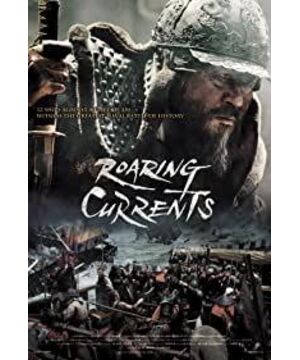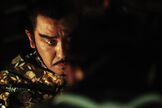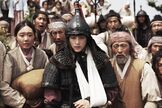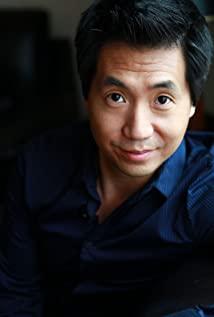The North Koreans, my tongue in the northeast, can break my throat if I enter, retreat and withdraw my barrier, and disturb it will lose my face.
This is the actual meaning of the previous Korean Wars. Of course, the Mingliang Sea Battle in the film has little to do with us. Therefore, this is also a historical event that the "self-reliant" Koreans are most willing to use for artistic processing.
But in my opinion, these artistic processes not only failed to establish a good image for Yi Sun-sin, but also made people feel more alienated from Yi Sun-sin. Because the director and screenwriter did not really portray a military strategist who was extremely good at naval warfare, but created a lonely heroic patriotic general who is not understood by others.
Perhaps it was the same as at the time. Those who knew him better were the naval generals of the Ming army, not his colleagues. How lonely it must be for this emperor to accompany his ministers.
This point, when I saw the movie, it was written in the imperial decree given to him by King Seongjo of the Joseon Dynasty. When I was in the 30th year of Wanli, I had a deep understanding.
Mencius said that the time of the sky is not as good as the land, and the land is not as good as the people. I don't know what Sun Tzu thinks about this. Anyway, as a layman, I think this is quite correct, and probably Yi Sun-shin himself would not object.
But in the movie, the Mingliang Sea Battle, a classic battle where less wins more, occupies the right time and place, but ignores "people and people".
Of course, the director did not completely give up "people and people", but in order to focus on this point, he transformed the whole story from beginning to end, telling how the comeback Yi Sun-sin gathered people's hearts and turned everyone's fear into courage, but such a Come on, the strategy in the battle, the real weapon used to defeat the Japanese pirates, has become a joke. Of course, these questions will only be discovered by the audience who will ask, "Can you defeat the Japanese pirates in this way?"
At that time, Japan was at the end of the Warring States Period and had just been unified under the command of Toyotomi (the end of the Warring States period was marked by the Battle of Sekigahara two years after the battle), and most of the samurai who survived the chaotic world had nothing to do with jackals. Different, see human life like a mustard. Therefore, these Japanese troops, who have fought bloody battles for decades, are relatively high in morale and even in individual combat. This is also the reason why North Korea collapsed at the touch of a button and the Ming army could not fight hard.
However, the Chinese and Korean armies also have the key to victory, which is artillery and ships. This is actually reflected in the movie. As the standard of naval warfare in everyone's concept, "strong ships and sharp guns", the North Korean side is basically equipped with ship-borne cannons and even "rockets", but Japanese pirates are all Relying on the fire gun as the main weapon, at most there are a few large fire guns (large barrels), and it is not very useful.
You must know that the range of cannons and cannons is not an order of magnitude. As for the "hard ship", let alone how capable the turtle ship transformed by Yi Sun-sin was based on the scorpion (Japanese pirates reported in Toyotomi Hideyoshi's battle report). It is said, "The Koreans' water warfare is very different from land warfare, and the warships are large and fast, the building is strong, and the guns and pills cannot enter. My ship encountered it, and it was all smashed"), even in the film That kind of North Korea's main warship, the Panokyo, can knock Japanese pirates' ships (it should not be closed, but transport ships) into pieces, and you will know how much the two sides have in terms of the quality of the ships and weapons. Gap.
Therefore, this battle is based on less winning more, but it is by no means weak. There is no irreversible gap between the two in terms of strength. It can be called a miracle, and it is definitely not like the description in the movie. miracle.
Sort it out from before the war, and compare the gap between the movie and the actual battle.
The Joseon navy was almost wiped out by Japanese pirates in the Battle of Qicheonyang (July 1597, three months before the battle), only because of Xiang Weng (the moustache at the beginning of the movie, and then burned the turtle ship to escape, The one who was shot to death) escaped, only to retain twelve warships. This is the full combat power of the Joseon navy, and it is also the capital that Yi Sun-shin used to turn the book.
On the Japanese side, they thought they had completely wiped out the North Korean navy and gained the coveted sea control, so they seemed a little reckless. At that time, the plan of the Japanese pirates was to use the navy, in cooperation with the army, to sweep the southern part of Korea and the islands in the sea. Therefore, among the more than 300 ships, about 200 are transport ships, mainly supplying the army.
In the movie, the Japanese army came with a huge fleet, while Yi Sun-sin was determined to die for his country and wanted to bring his only thirteen warships (there was a newly built turtle ship, which was later burned down) ) to fight to the death. During the pre-war preparations, the Korean side was disillusioned, and even the Korean king Li Heng gave him an decree, asking him to go ashore to fight. However, Yi Sun-sin still insisted on being me and decided to fight. This kind of battle plan of hitting the stone with eggs made the army very unstable. In addition, the Japanese pirates sent a boatload of heads to threaten them, so deserters appeared.
If there is a deserter, there will be a second one, so, Yi Sun-sin cut it with one knife (the art is so good, the sword is basically at the level of Zhan Lu, and then once again cut through the head, effortlessly, there is such a magic weapon , with one enemy a hundred, what is the way). Then, the "fleeing general" appeared. This guy not only sent someone to assassinate Yi Sun-sin, but also set fire to Yi Sun-sin's most precious turtle ship (I checked it, and it is true that this man escaped and was shot to death).
Later, those water envoys (probably at the level of captains, or captains) also came to ask again not to fight. What did Yi Sun-sin do in return? They burned all the tents and forced them all to sleep on the boat.
In the movie, Yi Sun-sin told his sons that he wanted them to turn their fear into courage. It seems to be a bit of a feeling of breaking the boat, but if the situation is really like this, knowing that you are going to die, can you stop it by killing deserters? It seems that it is not so easy to achieve, right?
So, at the beginning of the naval battle, of the twelve warships, only Yi Sun-sin's ship headed towards the enemy, while the other eleven stopped in place to watch.
However, Yi Sun-sin's ship really held back the attack of dozens of Japanese pirates. First, there was a round of artillery bombardment, which destroyed a lot. During the hand-to-hand battle with three or four Japanese pirate warships, they still relied on the cannon to stand up.
Then, the vortex appeared.
And the plot used to express the unity of the army and the people, in addition to the dumb girl sending the signal to avoid the bombing of Yi Sun-sin's ship, there are so many people rowing small wooden boats, who just pulled Yi Sun-sin's Panokyo out. swirl.
It was so touching, but also so imaginative. You must know that the whirlpool is not a constant position, and may engulf their boat at any time. However, the vortex was opened by the Koreans, only stirring the boats of the Japanese pirates, but not the small wooden planks of the Korean people.
Of course, the most ridiculous thing is not these, nor the Iga (ninja) who used the fire gun as a sniper rifle, but these twelve panyas directly rammed into the Japanese pirates' fleet, and they were not damaged in themselves. Under the circumstances, it directly rammed and sank countless Japanese pirates. With this kind of crushing ability, do you still need to be afraid of a bird before the war?
And it is very ironic that the enemy general Kato Yoshiaki said at this time, is this his resourcefulness?
First use one ship to attract firepower, then kill the navy of Kazushimatsu (dozens of warships), and then take the other eleven ships to directly crush the main navy of Kato Yoshiaki and Wakisaka Anji. Is it ingenuity? This is simply and rudely doing it directly.
But in fact, according to historical records (it is said that the director consulted such historical materials as "The Diary of Chaos", "The True Record of Xuanzu", "The Complete Book of Li Zhongwu", etc., and personally brought experts to check the local weather and terrain at that time, but he still I chose a most heroic story), this is not a positional battle with an egg hitting a stone, but an ambush battle.
In fact, Yi Sun-sin has occupied "people and people" from the beginning, and he has always been famous for "not fighting unprepared battles". In addition to personally surveying the terrain and studying the timing, he has also mobilized the masses to bury them in the Mingliang Strait in advance. Down the stake, pulled up the chain.
Mingyang Strait is a strait between Jindo and the Korean Peninsula. The terrain here is very special. Not only is the water shallow and the strait narrow, but the current is very unstable. How narrow is this strait, Du Niang said, it is only 249 meters, and it can pull up an iron cable. In addition, the current of Mingliang Strait is also very strange, and it reverses direction every few hours. Not only that, its tidal drop is also huge, and it is said that it can reach a drop of ten meters in a short period of time. When the current reverses and the tide rises and falls, there will be a huge noise in the strait, which is the origin of the name "Ming Liang".
Du Niang also said that today's Mingliang Strait has the world's largest tidal power station. You can imagine how unsettled the water is here, but the Japanese pirates don't know. Furthermore, if the Japanese pirates wanted to choose a sea area as a battlefield, would they choose a narrow sea area such as Mingliang Strait, which is not suitable for taking advantage of numbers, even if they did not know the hydrological conditions of the place?
The difference between positional warfare and ambush warfare is clear at a glance.
You said that the Koreans at that time were not afraid of Japanese pirates, they were afraid. But you said that these navy soldiers were afraid to follow Yi Sun-sin to fight against Japanese pirates? Certainly not afraid, this is all afraid, then it is better to surrender. Because everyone knows that Yi Sun-sin is brave and resourceful, and will never fight a war to the death in vain. This is why he was able to come back. The North Korean navy all miss this general who can win the battle. He has occupied "ren and people" from the very beginning of his return.
Yi Sun-sin was still very well prepared for this battle. After all, he wasn't filming a movie, so he wasn't sure that he could cut off the head of the enemy general with one blow, and he wasn't sure where he could shoot when he opened fire. where. Making a movie with hand-to-hand combat can especially show the heroic spirit of the protagonist, but for Yi Sun-sin, this will directly destroy his plan.
What is his plan? Send a warship to lure the enemy into Mingliang Strait.
Yes, in the movie, these guys are going for Yi Sun-sin, but in fact, no one is going to play a showdown with you with a transport ship. Japanese pirate's admiral, Todo Takatoro, is taking a large army to escort the transport ship. In addition to the mission of sweeping the waters of Jeolla-do, he also supports the Japanese army in southern Korea.
After the Japanese pirates discovered the warships sent by Yi Sun-sin (it was not certain whether Yi Sun-sin was on board), Tengtang Gaohu took about 30 off-ships as the vanguard, throwing off the large troops to pursue the North Korean navy.
After chasing the Mingyang Strait, the Japanese pirates encountered Yi Sun-sin's fleet (it is said that he also mobilized more than 100 small boats disguised as military ships to make a big splash). The two sides opened fire, but because Yi Sun-sin's side had a mountain cover, the Japanese pirates still couldn't make a quick battle despite the superiority of their troops.
Just when the two sides were at a stalemate, a whirlpool appeared. The ships of the Japanese pirates were sharp-bottomed ships. The hulls of the ships were unstable in the current and became a mess. The North Korean navy, who was suitable for offshore warfare, took the opportunity to start a full-scale counterattack. .
The main force of the Japanese pirates came to the rescue, and the tide began to ebb again when the sea water hit. At this time, Yi Sun-sin mobilized the people to bury the wooden stakes and the iron cables hidden in the water to play a huge role. Not only did the Japanese pirates' ships fail to advance or retreat, but they also crashed a lot.
Yi Sun-sin seized the opportunity and launched a heavy artillery bombardment (in hand-to-hand combat, would North Korea only have 34 killed?). In the entire Wanli Korean War, the only daimyo who was killed was killed by random cannons at this time. Yes, this person is described as One Piece in the film, and he made a special trip to find Yi Shun-shin to die, but in fact, he was born in the Murakami Navy, obeyed the Maori family, and then switched to the Oda family. During the Wanli Korean War. At that time, there were four Izumo guardians, a standard daimyo (feudal lord, that is, a big landlord who was a samurai).
Although the film said that the Japanese lost 8,000 people in this battle, almost the entire army was wiped out, but this is North Korea's consistent propaganda. Even Yi Sun-sin himself only dared to say that "30 pirate ships crashed through", and the casualties of Japanese pirates were not high. It may be too big (no wonder the director dared to decide the scene of the houseboat rushing into the Japanese pirate fleet, just to explain how the 8,000 Japanese pirates were killed. Unfortunately, it deviates from reality and ruins Yi Sun-shin's strategy).
Because, after Yi Sun-sin achieved the victory, he retreated at dusk. The most important thing is that the Japanese pirates still proceeded according to the original plan and completed their scheduled tasks, that is, they supported the army, swept the sea area, and destroyed the North Korean naval base, the Youshui Battalion, and also captured the other end of the Mingliang Strait. Jindo.
To sum up, Yi Sun-sin set up an ambush in the Mingliang Strait by taking advantage of the right time and place, to lure Japanese pirates to fight, and successfully ambush the enemy, achieving certain results. It is quite exciting in terms of strategy, but the scene is definitely not as good as the movie, because the twelve warships are firing guns in the distance. With the advantage of the range of firearms, they can effectively kill the enemy. If you really want to rush in, not only will the casualties be very serious. , it is difficult to say the geometry of victory or defeat.
Finally, I would like to say again, the significance of Mingliang sea battle. Is this battle meaningful? For the North Koreans, it was quite big, because the twelve warships still won against the Japanese pirates navy ten times their own, which can definitely boost morale, which is also quite beneficial to Yi Sun-sin's personal prestige, and at that time, A coach who can convince the entire army, unite and sacrifice for the country is the greatest strength.
But for the Japanese pirates, although this battle was an ugly loss, and a big name was killed in the battle, it was not at all traumatic. As for North Korea's claim of destroying the logistics supply and preventing the Japanese army from advancing westward, that is absolutely nothing, because the next move of the Japanese army proves that he has still completed the strategic goal and continued to control the sea. Moreover, the land battle situation has not changed because of this, and the Ming army is still fighting hard with Japanese pirates that are several times larger than themselves.
It can be said that in order to make Yi Sun-sin's heroic image more stalwart, to highlight his uniqueness, and to make him incomprehensible, the director not only made him force the soldiers to attack the stone with eggs, but also made him and the enemy carry out unequal actions. In hand-to-hand combat, life and death were on the line, and he unconsciously ignored his strategy. In order to "prove" the exaggerated military exploits, he even arranged a scene in which the Panokyo rushes directly into the Japanese pirates fleet and smashes them all.
The only drama that reflects the unity of the army and the people is that the people are rowing a small board to rescue the Yi Sun-sin ship in the whirlpool. Such a nonsense plot really tests the director's IQ.
If you die, you will live, if you are lucky, you will die (in the movie, it is "Alive or die"). It is indeed very war-wisdom, but in this strategically winning ambush battle, this truth is not reflected. It can be said that the director grasped this sentence, which confuses the audience very well and improves the compulsion, but turns Yi Sun-sin from a very strategic military strategist into a fierce warrior in desperate situation.
The "vortex" has become a foil. One ship can withstand the attacks of dozens of ships, and it also won a hand-to-hand battle with four ships. In the end, twelve itabayas crushed the main naval force of Japanese pirates. Is this a classic example of winning more with less and winning thrills? This is called equipment superiority. The soldiers have a great advantage. The advanced defeated the backward "massacre".
Does the director really understand Yi Sun-shin? It's just that South Korea needs a god-like "national hero". What it needs is to say a few words from Yi Sun-sin's mouth that are in line with the concept of modern people to encourage the people.
Who would want to know, how did Yi Sun-sin defeat the Japanese pirates?
A story that is not reasonable enough, no matter how wonderful it is, can't resist the audience's doubts. This leads to one problem after another.
"This battle is too fake. Yi Sun-sin made it up."
"Is it useful to kill a deserter when you know that you are going to die? Fear spreads, and the soldiers know that there is no certainty of victory. Let's flee first."
"Since the Japanese ships are like tofu in front of the North Korean ships, they can collide at will. With such a huge advantage in equipment, what is there to be afraid of?"
"Since Yi Sun-sin has completely wiped out the Japanese pirates' navy, he has to fight against the Japanese. Did the Ming army ask for help?"
"It turns out that Yi Sun-shin all depended on hard work and luck, so what's so great?"
...
At the end of the whole film, what I remember most is such a plot. After the victory, there was an atmosphere of joy everywhere in the North Korean ship. One soldier said that he glared at a Japanese pirate, and then the Japanese pirate was so scared that he wet his pants.
I think that's what is popular among Koreans. Therefore, after the Wanli Korean War, North Korea clung to the thigh of the Ming Dynasty even more, and after World War II, South Korea let the US military stationed in its own territory.
Every time we fought the Korean War, it was not easy for us, although, we just didn't lose. But those soldiers and soldiers who gave their lives for the country, those soldiers who fought for the interests of the motherland, their wisdom and blood and sweat, we must not forget.
We don't need a deified general to inspire our spirits. The real respect is to believe in the cruelty of reality and the darkness of truth, and still not forget the sincere gratitude and admiration for these ordinary and extraordinary people.
May the hardships they endured do not let us repeat the same mistakes.
For the whole of North Korea, if such a concept is allowed to spread, the deified Yi Sun-sin never existed and will not appear again. When a new military genius is born, he is a real human being with flesh and blood, and he will inevitably be dusted again. will star.
Just like Zhuge Liang, he only lives in books, hearts, and legends. No one knows how his ingenuity is passed down, and how the Eight Trigrams Array, Wooden Niu Liuma, Zhuge Liannu, and how many people understand. But fortunately, Sun Tzu's art of war is still there.
Authenticity is the heaviest respect, and it is the life of a biographical film. If details such as artifacts are considered, but reasonable logic is discarded, the entire story is of the same value as a fictional novel.
Fortunately, they also have a group of hard-working actors who perform the predetermined roles to the fullest, setting aside these deep meanings. As a main theme film that incites national sentiment and gathers people's hearts, the director has done a very successful job. Hopefully, when the Japanese pirates attack, the spirit of Yi Sun-shin portrayed in the movie will come in handy.
Because the sky will never resurrect Yi Sun-sin.
View more about The Admiral: Roaring Currents reviews











